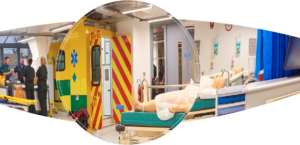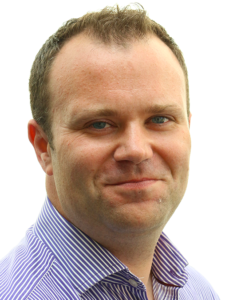Barry Matthews (Lecturer in Paramedic Practice and Pre-hospital Care) based at Edge Hill University’s Manchester Campus. Barry has been trying out Learning Services’ Giroptic 360cam, to create immersive resources for his students.
The Giroptic 360cam produces 360° photographs and video and was the topic, back in January 2017, of Mark Wilcock’s blog post “360 Degrees of Learning Potential”.
Barry agreed to talk to us (on video) about his experience of using the 360cam and his ambition to expose his students to as many on-the-job challenges and dangers as possible, without putting them in harms way. He is convinced that the introduction of immersive technologies has the potential for doing this. Read on and learn more about Barry’s vision to offer an immersive experience for his students, which might otherwise be impossible to do within the safe and controlled environment of a classroom or simulation centre.
Read on and learn more about Barry’s vision to offer an immersive experience for his students, which might otherwise be impossible to do within the safe and controlled environment of a classroom or simulation centre.
“The paramedic team have recently been experimenting with social media to reach current and future students/applicants. We have found that a lot of applicants attend open days at the Ormskirk campus and that their attendance at the interview day is the first time they have ever seen inside the Manchester site (St James’). I wanted to use the 360cam to give prospective students a view of what resources and facilities are utilised at St James’ and to give them a chance to see the bespoke teaching environment, clinical skills area and of course, the ambulance.
This mini-proje ct of these images for social media was to gain some experience of using a 360cam, and discover its potential and limitations. It was easy to use, but as St James’ has multiple companies with multiple Wi-Fi networks, a stable connection to a weak standalone Wi-Fi was impossible. This meant I had to set the camera up, push the shutter button and run. This was not particularly easy with so many reflective surfaces! I had to be inventive with my camera placement, opening doors to change the reflective angle of the glass and setting up somewhere near to hide. I do have some nice photos of a garden taken using the Wi-Fi at 10m, so it does work outside of this Wi-Fi jungle.
ct of these images for social media was to gain some experience of using a 360cam, and discover its potential and limitations. It was easy to use, but as St James’ has multiple companies with multiple Wi-Fi networks, a stable connection to a weak standalone Wi-Fi was impossible. This meant I had to set the camera up, push the shutter button and run. This was not particularly easy with so many reflective surfaces! I had to be inventive with my camera placement, opening doors to change the reflective angle of the glass and setting up somewhere near to hide. I do have some nice photos of a garden taken using the Wi-Fi at 10m, so it does work outside of this Wi-Fi jungle.
The 360cam is a simple device to use and can be controlled by buttons on the device itself, or by using a mobile platform and its own Wi-Fi. This produces three images in 4k definition which the software stiches together to form a 300°x360° image, as a panoramic, that can be exported as a JPEG. I then uploaded the panoramic image into Facebook which transformed it into a photosphere which can be explored on any device. The only additional software I used was Adobe Photoshop to blur a face out of one of the pictures, which is available through the EU application catalogue.
The resolution of the images taken by the Giroptic 360cam are good, a little bit of noise, but useable. The video does not record in the same definition (2k) so I didn’t use this functionality as the images were more than sufficient for the aims of this task.
but useable. The video does not record in the same definition (2k) so I didn’t use this functionality as the images were more than sufficient for the aims of this task.
Within the paramedic team, we have a great many potential uses for a 360cam-like technology. Simulation training enhances skills such as functional expertise, problem-solving, decision making and team-based competences (Lateef, 2010). Ambulance crews can work in any environment, and at times these can be stressful. We want to simulate these stresses for our student paramedics by using immersive environments. We utilise a room which projects video on the walls, with sound, to recreate these stressful and potentially dangerous environments to prepare our students for practice in a safe and controlled way.
The recreation of an environment has been shown to increase student engagement; with a negative aspect being identified as at times the environment can be distracting to the student (Bradley, 2006). This is exactly what we want with a student on both the DipHE and BSc (Hons) Paramedic Practice programmes. The situations that they will be working in when they qualify can potentially be distracting and dangerous, so we want to prepare for them for this so they don’t lose focus of their environment. I have attended patients in football stadiums, on airport runways, between live motorway carriageways…. I could probably describe a patient in every environment you can think of, and add some to the list.
Another use for the 360cam we are looking to explore is the creation of images of potentially hazardous environments, such as ‘drug dens’, construction sites etc. The students can then practice their observational skills and identify individual hazards and use this to influence their dynamic operational risk assessment. It is important the students learn how to identify hazards before they develop in a safe and protective environment. Therefore they can maintain not only their own safety, but also the safety of their colleagues and their patient, in any environment or situation they are presented with.”
Barry Matthews
Lecturer in Paramedic Practice and Pre-hospital Care
Are you interested using this technology or looking to explore innovation in your area please get in touch with us. We’d be more than happy to answer any questions or just get in touch if you would simply like to know more!
Contact us by email [email protected] or phone us on Ext 7754.


